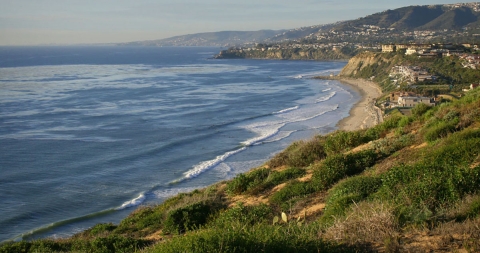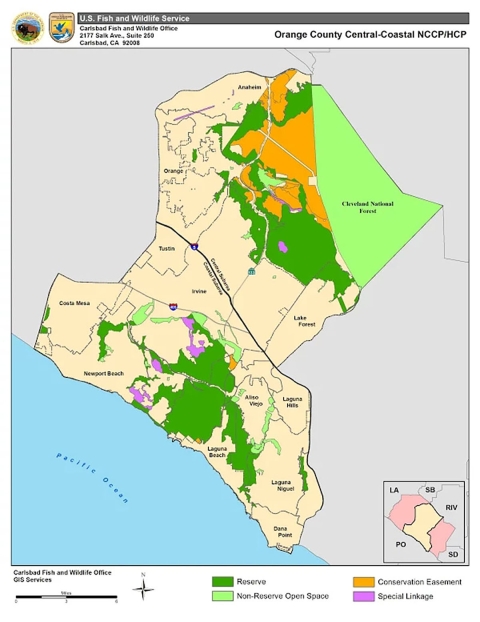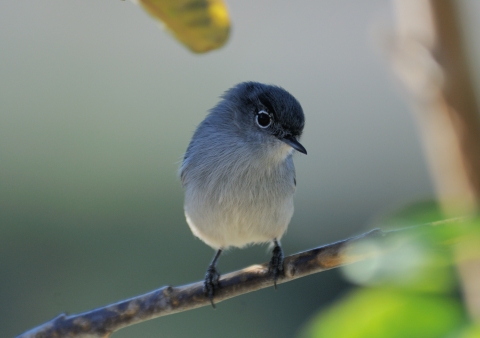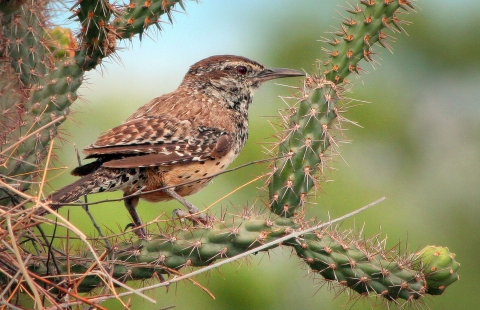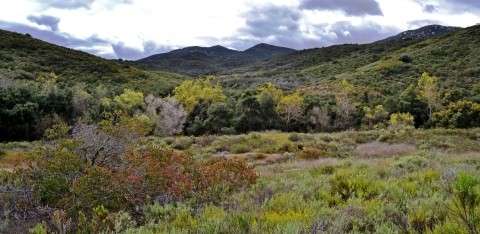Ever wondered how Orange County, one of southern California’s most populated areas, has managed to maintain large areas of open space? It's no secret that development is a big part of southern California’s identity; less well known is a 20-year landscape planning effort, that continues today, creating open spaces and conserving undeveloped, ecologically rich networks of preserved land in Orange County.
Preserving native open landscapes is no accident; it takes dedicated, sustained effort by people to make it happen. Equally as complex as urban planning, Orange County’s landscape design deliberately made space on the map for connected wildlife preserves. Popular open spaces in Orange County like Laguna Coast Wilderness Park and Irvine Regional Park, serve not only as recreation areas, but as homes for wildlife.
This ground-breaking conservation blueprint was sparked when the coastal California gnatcatcher was listed as a threatened species under the Endangered Species Act (ESA) in 1993. Many animals, including the gnatcatcher, rely on coastal sage scrub habitat. Historically, this native vegetation community dominated much of southern coastal California, including Orange County. During the economic boom of the 1980s, however, it was quickly giving way to houses, hotels, and other development.
The gnatcatcher, a modest blue-gray songbird, isn’t particularly eye-catching, but its listing under the ESA caught the eye and attention of a diverse group of people including developers and conservationists.
To protect it from further decline and possible endangerment, the Service needed to ensure it had ample habitat. At the time of listing, gnatcatchers were broadly, yet patchily, distributed across their range, and much of this remaining habitat was being considered for development.
Developers were concerned about costly delays while projects were reviewed and the Service was concerned about further fragmenting the gnatcatcher’s habitat. The Service adapted the ESA’s habitat conservation planning tool and brought unlikely allies together to create a strategy for balancing development and conservation across the landscape.
Rather than developing a habitat plan for each project, a regional conservation plan was developed to preserve blocks of habitat across Orange County, to streamline the process for developers, and protect 39 species of wildlife - both listed and unlisted.
The plan became known as the Orange County Central and Coastal Subregions Natural Community Conservation Plan and Habitat Conservation Plan.
Approved in 1996, it ensured that habitat lost to development was offset by conservation in specific areas to create a connected network of open space.
This Plan streamlined required work for developers and helped them meet the requirements of the ESA, all while guaranteeing habitat for wildlife including songbirds, lizards and tiny mammals. The plan is also approved by the State of California as a Natural Community Conservation Plan.
Many people made this landscape-level work possible. Participants in the plan include The Irvine Company, eight cities in Orange County, the Irvine Ranch Water District, County of Orange, UC Irvine, the Transportation Corridors Agency, and the California Department of Parks and Recreation.
Karen Goebel, Assistant Field Supervisor at the Service’s Carlsbad Office, has been involved with this plan since the early years and believes leadership and partnership is the key to conservation success, “Besides recognizing the Irvine Company for all they have done to support conservation in Orange County, what makes this plan stand out for me is the successful leadership structure of the Natural Communities Coalition, the entity responsible for monitoring this plan on the ground.”
Under the Plan, native wildlife were promised two large preserves totaling 37,000 acres, to remain untouched by development. As one of the leaders in developing the blueprint, The Irvine Company generously donated an additional 10,000 acres of land for preservation, above and beyond what the plan actually required, sending a message about the importance of conservation.
The promise has been fulfilled, and gnatcatchers, cactus wrens, orange-throated whiptails, Pacific pocket mice and more have a place to call home.
As we celebrate the 20th anniversary of the ground-breaking conservation Plan, the Service continues its work with our partners to maintain and enhance these habitat reserves in Orange County’s backyard.
We are also working to replicate this type of long-term planning in other areas of southern California, from San Diego County to the Coachella Valley. Preserving land and open space for wildlife and local communities doesn’t just happen. That’s the secret.
We are working with our partners to keep Orange County beautiful, to enhance quality of life, and to preserve habitat for wildlife who also call Orange County home.
This is landscape-level conservation.


